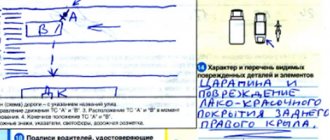When purchasing a compulsory motor liability insurance policy from any insurance company, a driver or a legal entity that has a fleet of vehicles on its balance sheet does not always realize and admit that the insurer may hold them accountable for damages in the event of an accident.
Dear readers! The article talks about typical ways to resolve legal issues, but each case is individual. If you want to find out how to solve your particular problem , contact a consultant:
+7 (499) 938-81-90 (Moscow)
+7 (812) 467-32-77 (Saint Petersburg)
8 (800) 301-79-36 (Regions)
APPLICATIONS AND CALLS ARE ACCEPTED 24/7 and 7 days a week.
It's fast and FREE !
And the whole point is in the intricacies of various mechanisms of insurance payments, all sorts of grounds that give the insurance company the right to demand compensation from the culprit of the accident, and his insurance will not help him.
Concepts
The easiest way to explain the meaning of the concepts “regression” and “subrogation” is with specific examples.
Subrogation
A car insured under an MTPL policy hits a pothole and is damaged. The insurer compensates him for the damage. But the road balance holder is to blame for the occurrence of an emergency. This is usually the local administration (roads within settlements) or the regional government (roads between settlements).
The company compensates the victim for damages, but may, in turn, make claims against the guilty party. This is subrogation.
Most often, this mechanism is used for payments under CASCO: the insurer reimburses compensation, then recovers its costs from the culprit or his insurance company.
Regression
If several cars were involved in an accident, and the culprit has a compulsory motor liability insurance policy, his insurance company will compensate the victims for damage within the limits established by law.
But in certain cases (the driver was not included in the insurance, was intoxicated, fled the scene of the accident), the insurer may recover the costs incurred from the culprit. This is a recourse claim against the culprit of the accident (regression).
Arbitrage practice
Compensation for damage by way of recourse has repeatedly been the subject of consideration by the Supreme Court of the Russian Federation. In particular, important procedural issues were reflected in the Practice Reviews for the 3rd quarter of 2015 and the 1st quarter of 2021. Let us highlight the most significant court decisions related to the recourse claim under OSAGO:
- if the insurer refuses to pay the victim, he cannot make any claims against the culprit of the accident;
- cases where the insurance company did not initially involve the guilty person in inspecting the damaged car are considered an abuse of law;
- recourse requirements cannot be applied to DSAGO policies that are voluntary in nature and do not fall under Law No. 40-FZ.
Another important order of the Supreme Court of the Russian Federation is compliance with the pre-trial procedure for resolving a dispute. The insurer has no right to file a claim in court until it sends a claim to the person responsible for the accident and waits for the result of its consideration. The time for consideration of letters of claim cannot be less than 30 days, as this complies with the norms of the Civil Code of the Russian Federation. If the claim procedure is violated, the claim must be denied.
If you are faced with a recourse claim from an insurance company under compulsory motor liability insurance, immediately contact our lawyers for a free consultation. The sooner you take protective measures, the greater your chances of avoiding payments after an accident. During the consultation, you will receive an explanation of the law and judicial practice, and you will be able to order the preparation of documents for the trial.
Features of subrogation
The development of the institution of subrogation solves several problems. Firstly, it limits the possibility of using various fraudulent schemes. Secondly, thanks to this system there is a legal way to recover damages from the real culprit of the incident. This is, in a sense, progress in insurance legislation.
The right of an insurance company to subrogation is prescribed in the Civil Code of the Russian Federation. And here it is indicated that the parties (insurer, policyholder) may refuse to use this process if the damage was caused unintentionally.
In other situations, not only insurance companies can request compensation (in the amount of costs incurred), but also victims if the insurance payment does not cover the amount of damage.
The insured may also waive claims against the person who caused the damage. In this case, the insurance company is exempt from paying compensation (in whole or in part).
In addition, which is logical, the volume of the insurer's claims within the framework of subrogation cannot exceed the amount of compensation paid to it.
Features of regression
The right of the insurance company to a recourse claim, according to which damage can be recovered from the policyholder, is prescribed in the law on compulsory motor liability insurance. If an insurance company client is found guilty of an accident, the organization will pay for the damage caused. But in some cases it has the right to recover compensation from him.
This may be in the following situations:
- Intentional damage.
- Driving while under the influence of alcohol (drugs, toxic substances).
- The culprit does not have documents allowing him to drive a vehicle.
- Escaping from the scene of an accident.
- The culprit is not included in the insurance.
- The MTPL policy is expired.
What the law says
All actions of insurance organizations are regulated by law, namely the Civil Code of Russia and the Federal Law “On Compulsory Motor Liability Insurance”. These two documents are the main ones in the relationship between the insurer and the policyholder. In addition, the rights of both parties are also regulated by the insurance contract, which is signed between the insurer and the policyholder.
IMPORTANT !!! As the law states, the insurer has the right to demand recourse not only from the driver who was at fault in the accident. He can also make a recourse claim to the operator who at a certain point organized a technical inspection of the car that was insured.
As a rule, the insurer can demand a refund from the operator only if defects were found in the car that caused the accident, but the operator did not notice them.
Comparison
Many people do not know that subrogation and subrogation in insurance have a fundamental difference.
Differences
Subrogation only implies a change in the party obligated to compensate for the damage caused. And recourse is a new requirement in accordance with which the insurer recovers its costs from the client.
There are also differences in the rules for calculating the limitation period.
Common features
The institutions of subrogation and recourse have an educational meaning. Thanks to these phenomena, the responsibility to compensate for the damage falls on those responsible for causing it.
Example
Let's say the owner of a car with a CASCO policy damaged the bumper by running over a curb. The insurance company will fully reimburse the costs of such an insured event (repairs). Since in this situation there is no second guilty party, there is no one to send a counterclaim to - it is impossible to apply regression and subrogation.
However, if the driver was intoxicated at the time of the accident, then the insurance company has the right to make a recourse claim against him.
If the collision with the curb occurred due to the fault of another person (for example, a driver who drove into oncoming traffic), then subrogation may be applied to him.
Regression under OSAGO
Recourse is the determination of the right of the insurance company to demand from the insured person (the culprit of the accident) compensation for losses incurred as a result of payment of compensation for the damage caused to him.
When can it be presented?
All cases that give the insurer the right to resort to regression are prescribed in the law on compulsory motor third-party liability insurance. Generally speaking, the insurance company client must not only be at fault for the accident, but also a violator under the insurance contract.
Is it possible to avoid
In order not to be subject to recourse, the person at fault for the accident should not violate the terms of the insurance contract and the norms prescribed in the law on compulsory motor liability insurance.
That is, take care of the relevance of the MTPL policy, do not drive while intoxicated, and in the event of an accident, do not panic and do not try to escape.
In what cases can they collect
Not only the insurance company can recover damages from the client (in case of violations that give it the right to a regressive claim), but also the victims. This is permissible if the insurance amount does not fully cover the damage caused by it. These issues are usually resolved in court if the culprit refused to pay compensation voluntarily.
Grounds for filing a recourse claim
All the grounds that give the insurance company the right to recourse are spelled out in Article 14 of the law on compulsory motor liability insurance.
The Investigative Committee may put forward a regressive claim against the culprit of the accident if the following facts are revealed:
- Intent. If damage to property, life or health was caused intentionally, then compensation for damage may be assigned to the person responsible for the accident.
- Drunk. Any intoxication (alcohol, drugs, toxic) gives the insurance company the right to impose financial liability on the culprit client.
- Management without rights. Regression can be caused by the insured not having documents allowing him to drive a car. You need to understand: if you simply don’t have a driver’s license with you (but you do have one), then this does not mean that you have no right to drive in general.
- Escaping from the scene of an accident. This is punishable by one to 1.5 years of deprivation of a driver's license or up to 15 days of arrest. In addition, in case of hiding, the culprit of the accident will have to independently compensate for the damage to the victims.
- Not covered by insurance. If the insurance policy is limited in the number of insured, and the culprit of the accident is not included in it, then he himself bears financial responsibility in the event of an accident.
- Expired insurance. Each policy specifies the period during which it is valid.
- Didn't notify the insurance company. If an accident is reported without calling the police, then the person responsible for the accident must notify his insurance company about the incident within five days. The client must provide the insurer, in addition to the notice, with a completed European protocol form. Otherwise, there is a risk of regression.
- Technical inspection. Many people think about getting a diagnostic certificate (technical inspection) just to apply for insurance. However, if the person at fault for the accident has an overdue inspection, then the cost of repairing the victim’s car will fall on his shoulders.
- False data in the electronic policy. If, in order to obtain an electronic compulsory motor liability insurance policy, the client provided the insurer with inaccurate data, as a result of which the amount of the insurance premium decreased, this is the basis for the use of a recourse mechanism.
- Other reasons. If an accident was reported without calling the police, then the culprit cannot begin repairing (disposing of) the vehicle involved in the accident until 15 calendar days have passed from the date of the incident. Non-working holidays are not taken into account. In addition, at the request of the insurance company, this vehicle must be provided for inspection and/or technical examination.
When can a claim be made?
According to the law, the insurance company has the right to present a recourse claim to its client only in certain situations, namely:
- If the initiator of an accident deliberately created a traffic accident, or used his vehicle in order to damage another person’s car.
- If the perpetrator was under the influence of alcohol or drugs. In this case, the insurer has the right to demand recourse only if it has an expert opinion on hand.
- If the person at fault for the accident never received a license or did not replace the old ones on time. As the law states, an issued driver's license is valid for only 10 years, after which it is mandatory to replace it.
- If the person at fault for the accident was not listed as the driver in the insurance policy. As a rule, when concluding an insurance contract, the car owner must indicate the persons who have the right to drive the vehicle.
- If the culprit of the accident was operating the car at a time when this should not have been done. For example, the insurance contract stated that the car would be used only in the summer, but in fact it was seen on the roads in winter.
- If the culprit of the accident left the scene of the accident. As prescribed by traffic regulations, both participants in a road accident are required to remain on the spot until the traffic police and the insurer arrive.
- If the person at fault for the accident did not provide the insurance company with all the necessary information about the accident. As a rule, the insurance contract always stipulates that the party at fault for the accident is obliged to provide the insurance company with certain documents within 5 days.
- If the person at fault for the accident began to repair the car without first coordinating his actions with his insurer. This rule applies exclusively for 15 days from the moment the accident occurred.
- If at the time of the accident the diagnostic card was no longer valid.
All of the above cases are grounds for the insurance company to make a recourse claim to its client.
How much can they charge?
As already mentioned, the amount of recourse claims cannot exceed the amount of compensation paid by the insurer to the victims.
In addition, the total amount of claims may include:
- the amount of compensation paid by the insurance company to the injured party;
- legal costs of the insurer;
- expenses of the Investigative Committee for carrying out the necessary examinations;
- expenses of the company for conducting insurance business (the amount is determined by the insurer).
The law defines the upper limits of payments under compulsory motor liability insurance for victims of road accidents. Compensation for property damage cannot exceed 400 thousand rubles, damage to health - 500 thousand rubles. That is, for each case, depending on the situation, a separate calculation will be carried out.
For example, after a road accident a European protocol was drawn up. The person at fault did not notify his insurance company about the accident. As a result of the accident, property damage in the amount of 170 thousand rubles was caused. The culprit's insurance company compensates the injured party for these losses and makes recourse claims to the client. The policyholder does not agree with them. The insurance company files a lawsuit, demanding that the client reimburse 170 thousand rubles. and the amount of legal costs, which, for example, amounted to 12 thousand rubles. Thus, the total amount of claims will be 182 thousand rubles.
We received a claim, what should we do to protect ourselves?
It often happens that after an accident, the person at fault simply forgets to notify his insurance company about what happened. And as a result, he receives a recourse claim for failure to submit a notice, how can he not pay it?
Before May 1, 2021, the insurance company had the right to demand recourse for failure to provide notification of an accident. Such a right took place on the basis of the Federal Law “On Compulsory Motor Liability Insurance”, namely its 2 articles, paragraph 11.1, as well as article 14. But with the onset of the designated date, paragraph “g”, 14 articles of the Federal Law - 40 lost its force. Therefore, if a recourse claim has been received on the basis that the person at fault for the accident did not present the relevant documents to the insurance company on time, and the accident occurred after May 1, 2021, then a consultant who knows this area will best help in this situation.
IMPORTANT !!! Only the actions of a competent specialist will help you protest the insurance company’s claim and avoid paying recourse.
Also, in this situation, you should not forget about the statute of limitations. As the legislation of the Russian Federation states, in 2021 the statute of limitations is three years. This is indicated in the Civil Code, namely in its 196th article. It is worth paying attention to the fact that the calculation of the statute of limitations does not begin from the moment of the accident, but only when the insurance organization has paid the injured party a payment.
How to deal with the culprits
In the event of an accident, the insurer examines the circumstances of the accident and finds out whether its client’s illegal actions were among its causes. If any, the company must prepare documents that will justify the amount of damage it has suffered and submit a claim to the insured person.
In such a situation, it is better not to try to evade responsibility. You must carefully read all documents. If the demands are fair, and the damages assessed correspond to those indicated in the protocol, then it is better to try to resolve the issue peacefully.
If the insurance company overestimates the amount of the claim, you must request copies of all documents and contact an independent appraiser. All disagreements are settled, as a rule, in court.
Useless disputes
Often clients refuse to pay under regression, citing the fact that they do not admit their guilt. This will not help you avoid payments. If the court establishes the fact of guilt during the proceedings regarding the accident, then it is not necessary to do this separately when submitting recourse claims.
If you have nothing to pay
There is a way out of any situation. One of them is an agreement with the insurance company, according to which compensation for a recourse claim can be paid in installments.
Another method is litigation. The insurer goes to court, and the court makes a decision to recover damages. After it comes into force, a writ of execution is issued, according to which the debt is automatically reimbursed from part of the debtor’s official income.








